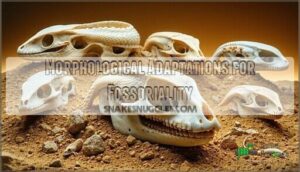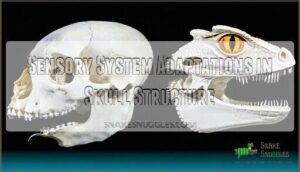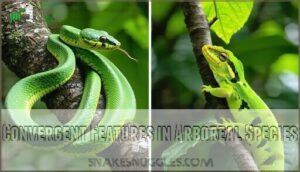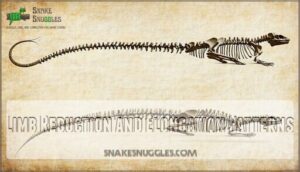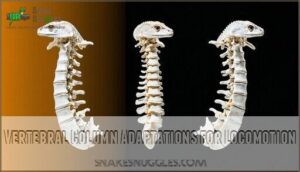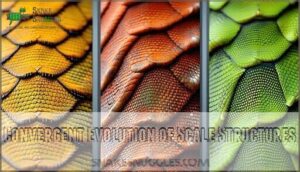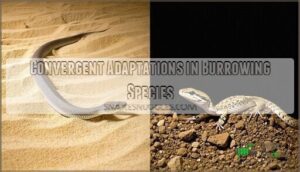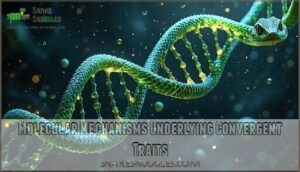This site is supported by our readers. We may earn a commission, at no cost to you, if you purchase through links.

Picture burrowing lizards and snakes: both flaunt elongated crania and bodies fit for underground life, even if their family trees barely cross. When you look closer, you’ll spot the genetic, behavioral, and anatomical shortcuts that let evolution rewrite the same winning formula—again and again.
Table Of Contents
- Key Takeaways
- Evolutionary Convergence in Snake and Lizard Skulls
- Convergent Body Plan Modifications in Squamates
- Ecological Drivers of Convergent Evolution
- Molecular Mechanisms Underlying Convergent Traits
- Evolutionary Rates and Convergence Patterns
- Frequently Asked Questions (FAQs)
- Are snake-like body shapes convergent?
- Did snakes evolve from lizards?
- Which lizard venoms undergo convergent evolution?
- What is an example of convergent evolution in lizards?
- Are snakes and lizards divergent or convergent?
- How did snakes and lizards evolve?
- How do snake and lizard diets influence convergence?
- What role does habitat play in convergence?
- Are mimicry patterns evidence of convergent evolution?
- Do behavioral traits show convergent evolution in reptiles?
- Conclusion
Key Takeaways
- Snakes and lizards have evolved remarkably similar body shapes and skull structures through convergent evolution, often responding to shared ecological pressures like burrowing, climbing, or hunting.
- Limb reduction, specialized skulls, and modified scales have independently appeared in many lineages, reflecting nature’s repeated solutions to common challenges.
- Molecular pathways and gene regulation often follow parallel tracks, meaning the same genes and genetic processes get repurposed across distant species for similar traits.
- Environmental factors like habitat, diet, and predation drive these reptiles to repeatedly evolve nearly identical adaptations, showing how flexible and inventive natural selection can be.
Evolutionary Convergence in Snake and Lizard Skulls
You’ll find that skull architecture in snakes and lizards reveals some of nature’s most striking examples of parallel evolution, where distantly related lineages independently arrived at remarkably similar solutions.
These adaptations offer a glimpse into how environmental challenges have creatively shaped skull structure along different evolutionary paths.
Morphological Adaptations for Fossoriality
When fossorial snakes and lizards shift to subterranean life, you’ll observe striking skull shape convergence. Burrowing snakes and lizards independently evolved compact, reinforced skulls with reduced diameters and elongate crania—adaptations that recur across at least 54 lepidosaur lineages.
Morphological evolution favors wedge-shaped heads with enlarged, smooth rostral scales for substrate penetration. These convergent traits in reptiles reflect functional performance demands: reinforced nasal regions withstand burrowing stresses, while limb reduction accompanies vertebral adaptations and scale modifications that boost fossorial efficiency.
Some snakes exhibit paedomorphosis in jaws, retaining juvenile features into adulthood.
Jaw Modifications for Gape-limited Predation
Beyond skull shape convergence, you’ll notice jaw modifications that tackle gape-limited predation head-on. Skull morphology in snakes reflects dietary specialization—Burmese pythons achieve gape areas 4–6 times greater than brown treesnakes, with soft tissue contributing 43% versus 17%. Your flexible skulls enable swallowing prey exceeding 50 kg through jaw mechanics optimized by skull biomechanics.
Gape allometry reveals negative scaling in many cranial dimensions, yet positive allometry emerges in measurements directly linked to prey ingestion.
Lizards show parallel jaw evolution—saurophagous species develop strong jaw muscles, while aquatic and herbivorous forms exhibit rapid cranial kinesis adaptations. This is partly due to lower jaw evolution within the lepidosaurs.
Cranial Kinesis in Specialized Feeders
While jaw modifications set the stage for managing oversized meals, you’ll find that cranial kinesis—the independent movement of skull bones—pushes feeding flexibility to its evolutionary extreme in specialized squamates.
Flexible skulls enable prey capture strategies through kinetic skull biomechanics, where quadrate bones pivot and palatine elements slide independently.
This skull flexibility creates feeding niche partitioning—egg-eating snakes collapse their skulls around prey, while varanid lizards deploy intracranial joints for subduing struggling victims.
These evolutionary trade-offs balance mobility against structural integrity, with skull flexibility limits preventing catastrophic bone displacement during violent feeding bouts.
Sensory System Adaptations in Skull Structure
Feeding mechanisms depend on more than mechanical advantage—your sensory systems must detect, track, and evaluate prey before those kinetic jaws ever spring into action. Convergent skull morphology accommodations drive sensory integration across squamate lineages:
- Infrared sensing through thermoreception organs embedded in facial pits (pythons) or labial scales (boas)
- Vision enhancements via specialized retinal adaptations for nocturnal hunting or ultraviolet detection
- Olfactory adaptations through expanded vomeronasal chambers and Jacobson’s organ modifications
In short, these kinesis-ready systems show that squamate skulls can house complex sensory hardware without sacrificing their strength when it matters most—right at the moment of striking prey.
Convergent Features in Arboreal Species
When arboreal snakes and lizards faced the challenge of traversing three-dimensional canopy environments, natural selection favored morphological innovations that transformed branch-dwelling from precarious perch to ecological opportunity.
You’ll notice convergent evolution in reptiles manifests through prehensile tails that anchor bodies during predation, grasping limbs with specialized adhesive scales in lizards, and elongated vertebral columns in snakes enabling precise weight distribution.
Camouflage patterns evolved independently—cryptic coloration matching bark textures or leaf patterns—while arboreal diets drove skull modifications for capturing mobile prey.
Sensory adaptations include binocular vision for depth perception and enhanced vestibular systems coordinating balance during arboreal living.
Convergent Body Plan Modifications in Squamates
When you examine squamates—snakes and their lizard relatives, you’ll notice striking examples of how different lineages independently evolved similar body forms in response to comparable ecological pressures.
Let’s explore the key anatomical transformations that arose multiple times across these reptilian groups, from limb loss to specialized scale arrangements.
Limb Reduction and Elongation Patterns
You’re witnessing one of evolution’s most compelling patterns: the repeated transformation from limbed to limbless forms across squamate reptiles. Limb reduction and body elongation showcase convergent evolution at its finest, with this dramatic shift occurring independently at least 26 times in squamate lineages—and partial limb reduction appearing in over 50 separate events. These convergent pathways toward a limbless body reflect shared ecological pressures, particularly the fossorial lifestyle that favors elongated, sleek forms for burrowing efficiency.
The mechanisms driving this transformation involve:
- Digit loss progression ranging from one or two phalanges to complete limb absence, often through heterochronic truncation
- Body elongation achieved by increasing presacral vertebral count beyond 30 in highly elongate taxa
- Genetic mechanisms including cis-regulatory changes in limb development genes like Tbx4, Fgf10, and Gli3
- Asymmetric reduction where hind limbs generally disappear before forelimbs in most lineages
- Evolutionary timeframes spanning from 200 million to 3.6 million years ago across different limbless origins
Snakes and lizards demonstrate that convergent evolution can produce strikingly similar solutions when facing comparable adaptive challenges.
Vertebral Column Adaptations for Locomotion
The vertebral column functions as evolution’s master blueprint for locomotor innovation, with snakes and lizards independently engineering remarkably similar skeletal modifications to conquer diverse habitats.
You’ll find vertebral flexibility maximized in snakes through increased presacral counts exceeding 300 vertebrae in some species, enabling the undulatory movements essential for limbless locomotion. Conversely, fossorial lizards demonstrate spinal rigidity through vertebral fusion, improving burrowing mechanics.
Convergent adaptations include:
- Enhanced muscle attachment sites for powerful aquatic propulsion in sea snakes and marine iguanas
- Zygosphene-zygantrum articulations reinforcing vertebral interlocking during constriction
- Regional vertebral specialization differentiating neck, trunk, and tail functions across squamates
Ultimately, these patterns of vertebral evolution underscore how natural selection can shape remarkably similar skeletal designs from entirely different ancestral roots.
Convergent Evolution of Scale Structures
Scale structures showcase evolution’s knack for reinvention, with unrelated squamates converging on nearly identical keratin-based solutions. You’ll discover that over 70% of snake species and 45% of skinks independently evolved overlapping scales, maximizing flexibility during locomotion.
Meanwhile, desert-dwelling lineages developed highly keratinized, armor-like scales that boost water retention—lipid layers in the stratum granulosum reduce moisture loss in arid habitats.
Ecological roles drive these molecular mechanisms: fossorial species feature smooth, reduced scale microstructures facilitating substrate penetration, while arboreal geckos display granular scales improving traction.
Across 153 taxa spanning all 67 squamate families, these convergences emerge as invaluable phylogenetic markers—offering a powerful toolkit for untangling complex evolutionary relationships.
Body Shape Changes for Aquatic Lifestyles
Aquatic squamates have rewritten their own blueprints, trading terrestrial versatility for hydrodynamic mastery in a transformation that rivals any engineering feat. You’ll observe contoured bodies engineered for minimal drag, while laterally compressed tails deliver powerful propulsion through undulatory locomotion.
Convergent evolution has shaped these reptiles’ respiratory changes—salt glands enable osmoregulation in marine environments, and specialized sensory adaptations detect pressure waves underwater.
Environmental adaptation has sculpted body shape across independent lineages, from sea snakes to marine iguanas, demonstrating how ecological pressures consistently forge similar morphological solutions in distantly related reptiles.
Convergent Adaptations in Burrowing Species
When you peer beneath the surface—literally—you’ll discover that fossorial squamates have independently engineered remarkably parallel solutions to the biomechanical challenges of subterranean life. Burrowing biomechanics have driven skull reinforcement in multiple lineages, producing wedge-shaped crania that function as excavation tools while protecting neural tissues.
Substrate interaction demands have shaped convergent body shapes through limb reduction, transforming appendages into sleek forms that won’t impede locomotion through compacted soil. You’ll recognize that sensory deprivation underground has recalibrated these reptiles’ reliance on chemoreception and tactile perception, demonstrating how convergent paths emerge when natural selection confronts similar environmental constraints in distantly related taxa.
Key fossorial morphology adaptations include:
- Compact, reinforced skulls with countersunk lower jaws that prevent soil accumulation
- Progressive limb reduction or complete loss, minimizing friction during forward propulsion
- Enhanced chemosensory organs compensating for diminished visual capacity in subterranean environments
Ecological Drivers of Convergent Evolution
You’ll find that environmental pressures shape these reptiles in remarkably parallel ways, driving similar solutions across unrelated lineages.
The following ecological factors illustrate how habitat, diet, predation risk, thermal demands, and reproduction sculpt convergent adaptations in snakes and lizards.
Habitat-specific Morphological Adaptations
From sandy dunes to tangled canopies, squamates have sculpted their bodies into habitat-specific masterpieces through parallel evolutionary pathways that mirror one another with striking precision. You’ll witness convergent evolution at work as environmental pressures drive adaptive radiation in both snakes and lizards, producing remarkably similar morphological constraints despite independent origins. Microhabitat specialization and niche partitioning have shaped these reptiles into ecological specialists:
| Habitat | Convergent Adaptation |
|---|---|
| Desert substrates | Wedge-shaped skulls, fringed scales |
| Fossorial environments | Reduced eyes, reinforced snouts |
| Arboreal canopies | Prehensile tails, specialized grip structures |
| Aquatic systems | Efficient shape, lateral compression |
| Rocky outcrops | Dorsoventrally flattened bodies, adhesive digits |
Each adaptation reflects how morphology reacts to habitat demands across these noteworthy reptiles.
Dietary Specializations and Convergent Traits
Across 1, 314 squamate species, dietary convergence tells an impressive story: snakes and lizards independently evolved vertebrate-feeding strategies from insect-eating ancestors, with colubriform snakes explaining 45% of current dietary specialization variance. Skull morphology tightly correlates with diet type—cranial kinesis, expanded gape, and reinforced jaw joints arise convergently when adapting to vertebrate prey.
Here’s how feeding strategies converge:
- Rear-fanged dentition and venom evolution for subduing dangerous prey
- Gape-limited predation modifications in jaw structure across Boidae, Colubridae, and Varanidae
- Specialized diets on colonial insect larvae in blindsnakes and fossorial lizards
- Vertebrate-dominated diets in Helodermatidae and Lialis, mirroring predatory snake patterns
Niche partitioning drives trophic evolution 3.2 times faster in snakes than lizards, with molecular mechanisms underlying these convergent traits revealing shared genetic pathways in developmental gene networks.
Predator Avoidance Strategies and Body Forms
You might think snakes and lizards have evolution’s toughest job nailed—hunting prey—but staying alive means they’ve had to get equally creative about avoiding becoming lunch themselves. Predator avoidance strategies reveal striking behavioral convergence, with both lineages independently evolving similar defensive morphology under comparable ecological pressures.
Camouflage evolution produces cryptic coloration in fossorial species, while mimicry adaptations—exemplified by harmless colubrids resembling venomous elapids—demonstrate convergent evolution operating at phenotypic and behavioral levels. Escape mechanisms converge on lithe body shapes enabling rapid retreat into microhabitats.
| Strategy | Convergent Examples |
|---|---|
| Crypsis | Leaf-mimicking vine snakes, green anoles |
| Autotomy | Glass lizards, brittlesnakes |
| Aposematism | Coral snakes, fire-bellied newts |
| Speed-enhanced morphology | Whiptails, racers |
| Burrowing refuge | Blind snakes, legless lizards |
All of these convergent traits underscore just how strongly the threat of predators influences the evolution of reptile body forms in different lineages.
Thermal Regulation and Convergent Features
While dodging predators keeps squamates alive, managing their internal temperature determines whether they can move, hunt, or even digest that hard-won meal in the first place.
You’ll observe striking convergent evolution in thermal regulation across snakes and lizards facing similar environmental challenges. Both lineages independently evolved parallel solutions:
- Behavioral Thermoregulation through shuttling between sun and shade
- Convergent Pigmentation patterns maximizing heat absorption in cooler climates
- Body flattening increasing surface area for efficient heat exchange
- Insulation Strategies via scale modifications controlling heat retention
In short, these convergent traits highlight how thermoregulation in ectotherms profoundly influences reptile form—driven by shared, underlying molecular pathways that fine-tune their metabolism.
Reproductive Strategies Influencing Body Shape
If you’ve ever watched a gravid female snake glide with surprising grace despite carrying a belly full of developing offspring, you’ve witnessed how reproductive demands sculpt body architecture in real time. Convergent evolution shapes body form across squamates through distinct reproductive strategies. Viviparous species—those retaining eggs internally—exhibit elongated trunks accommodating extended gestation periods, while oviparous lineages modify pelvic dimensions for egg size and clutch size. Sexual dimorphism emerges independently when parental care demands differ between sexes.
Consider these convergent adaptations:
- Limb reduction enhances flexibility during pregnancy in live-bearing species
- Body cavity elongation maximizes embryonic space without compromising locomotion
- Convergent pelvic modifications facilitate clutch passage across unrelated lineages
You’ll find these evolutionary adaptations repeatedly reinvented wherever reproductive pressures intersect with ecological constraints.
Molecular Mechanisms Underlying Convergent Traits
You can’t fully grasp convergent evolution without understanding what’s happening beneath the surface—at the molecular level.
Let’s explore the genetic pathways, regulatory shifts, and genomic signatures that drive these striking parallel adaptations in snakes and lizards.
Shared Genetic Pathways in Limb Reduction
Limb reduction in squamates reveals striking genetic convergence despite independent evolutionary origins. Multiple species manipulate the same developmental pathways to achieve similar morphological outcomes.
Genomic analyses demonstrate that Hox Gene Degeneration occurs repeatedly, with genes like Hoxa5, Hoxa11, Hoxc11, and Hoxd13 showing relaxed selective constraints across snake lineages and limbless lizards.
The SHH Pathway and FGF8 Signaling regulate digit formation through expression duration—shorter activation periods correlate with fewer digits and progressive limb loss. Regulatory Mutations in conserved non-coding elements alter transcription factor binding sites, modulating limb initiation genes such as Tbx4 and Fgf10.
CNE Degeneration accumulates at rates of 3.9–7.63 per million years in these lineages, with approximately 546 convergent degenerated elements overlapping limb development enhancers, illustrating how genetic pathways converge to produce strikingly similar phenotypes across distantly related taxa.
Convergent Regulatory Changes in Scale Development
When reptilian skin appendages undergo radical transformation, the regulatory networks orchestrating scale architecture reveal parallel molecular innovations across phylogenetically distant lineages. Keratin evolution and EDC gene loss dominate these shifts—comparative genomics demonstrates that snakes and limbless lizards independently shed multiple epidermal differentiation complex genes controlling scale morphology.
Consider how convergent evolution operates:
- Regulatory elements governing scale gene regulation undergo parallel modifications in squamates
- Microstructure convergence emerges through similar alterations in cis-regulatory domains
- Regulatory divergence paradoxically produces identical phenotypic outcomes across distantly related taxa
In essence, these molecular patterns highlight how nature often lands on the same genetic solutions when similar selective forces are at play.
Molecular Basis of Venom Evolution
Squamate venom systems illustrate mutation-driven adaptations through tandem gene duplication, with up to 90% of venom gene families arising from these events. Toxin recruitment repeatedly co-opts physiological proteins—cysteine-rich secretory proteins and kallikrein-like serine proteases independently evolved into lethal brew components across snake and lizard lineages.
Regulatory mechanisms controlling venom gene evolution leverage pre-existing salivary networks, while phylogenetic patterns reveal the Toxicofera clade’s shared homologous venom genes span 60% of living squamates.
This molecular basis of adaptation demonstrates how nature engineers toxin diversity through convergent genetic pathways rather than single evolutionary origins.
Genomic Signatures of Convergent Skull Modifications
Comparative genomics has revealed a striking pattern: independent losses of claw-related keratin and EDC genes mark the convergent skull modifications in both snakes and limbless lizards, revealing that nature’s architectural blueprints for fossorial skulls operate through parallel genetic erosion rather than novel innovation.
Under the hood, you see four main threads weaving the tapestry of squamate skull convergence:
- Gene expression shifts reshape cranial tissues.
- Regulatory elements fine-tune skull development.
- Cranial enhancers reshape genome architecture.
- Sequence erosion aligns skull morphology and adaptations across disparate lineages.
Parallel Changes in Developmental Gene Networks
It’s wild to realize that, deep in the tangled web of DNA, snakes and lizards keep repurposing the same genetic playbook for skull transformation—with each species adding its own spin to nature’s greatest hits.
Gene network convergence shines here: think Hox genes, Wnt signaling, BMP pathways. Each thread pulls developmental pathway parallels and regulatory element sharing into bold relief, echoing themes of transcriptional factor reuse.
This intricate signaling cascade evolution neatly sums up the profound molecular mechanisms of convergence shaping the skulls of these fascinating reptiles.
Evolutionary Rates and Convergence Patterns
Understanding how quickly and in what patterns snakes and lizards have changed sheds light on their shared evolutionary journey.
Here’s how we can break down the major trends that define their paths.
Comparative Analysis of Phenotypic Evolutionary Rates
Though snakes and lizards stand worlds apart on the reptilian family tree, evolutionary rates show just how quickly convergent evolution can redraw ancestral blueprints. Using phylogenetic analysis, researchers uncover Rate Heterogeneity—some skull regions in squamates evolve at breakneck speed while others linger. These rapid bursts often align with Ecological Shifts, reveal strong Phylogenetic Signal, and sometimes evoke a Macroevolutionary Singularity shaped by relentless Functional Selection.
- Rapid skull evolution in snake jaw joints
- Ecological transitions fuel morphological innovation
- Phylogenetic analysis quantifies trait velocity
- Functional demands target cranial biomechanics
- Macroevolutionary singularity pinpoints snake origins
Temporal Patterns in Convergent Trait Acquisition
Just as evolutionary rates set the stage for dramatic change, the tempo of convergent traits appearing across snake and lizard lineages tells its own story of bursts, slowdowns, and opportunistic leaps. Trait acquisition timing hinges on evolutionary rate variation and the ecological pulse—periods of rapid environmental change, mapped through ancestral reconstruction, often spark evolutionary bursts. Character mapping reveals that ancestral state influence shapes which lineages respond first.
| Burst Trigger | Evolutionary Outcome |
|---|---|
| Ecological Shifts | Rapid Trait Convergence |
| Extinction Event Impact | Delayed Adaptation |
Influence of Mass Extinctions on Convergent Evolution
Sometimes, it takes the upheaval of a mass extinction to push snakes and lizards into reinventing themselves, unlocking whole new waves of similarity as fresh habitats open up. Imagine this evolutionary reset, where:
- Extinction Event Impact carves out new space
- Niche Availability skyrockets
- Adaptive Radiation flourishes
- Evolutionary Bottlenecks funnel diversity
- Recovery Trajectories steer convergent evolution in reptiles
Rates of Molecular Evolution in Convergent Lineages
With each evolutionary restart, snakes and lizards don’t just pick up new traits—they put their own genetic clocks to the test, racing ahead or slowing down as selective pressures push their molecular blueprints in remarkably familiar directions.
Mutation accumulation, selection intensity, and functional constraint weave a story of rate heterogeneity and adaptive bursts, driving molecular evolution toward the uncanny patterns of convergent evolution.
Phylogenetic Distribution of Convergent Features
Across the squamate phylogeny, you frequently encounter clade-specific traits woven from independent origins—think snake-like bodies sprouting up in unrelated lizard groups. This tapestry of morphological convergence shows up vividly when tracking:
- Phylogenetic clustering of features
- Shift frequency in tail morphology
- Multiple independent origins of similar traits
- Clade-specific adaptations responding to shared selective pressures
Frequently Asked Questions (FAQs)
Are snake-like body shapes convergent?
Could you imagine two strangers showing up to a masquerade in nearly identical costumes?
That’s what you see with snake-like body shapes—distinct lizard groups, sculpted by selective pressures and developmental pathways, converging on that serpentine form.
Did snakes evolve from lizards?
Surprised to learn snakes once had legs? Lizard Ancestry is well established: Genetic Evidence and Intermediate Fossils reveal Snake Phylogeny tracing to ancient lizards.
Morphological Clues like limb loss in squamates highlight evolution’s creative power.
Which lizard venoms undergo convergent evolution?
Think molecular convergence is rare? Think again. Monitor lizards and Gila monsters, both anguimorphs, independently evolved strikingly similar venom composition—especially kallikrein enzymes.
Yet, their delivery mechanisms, toxin targets, and gland morphology echo evolutionary ingenuity and adaptability.
What is an example of convergent evolution in lizards?
Much like artists painting the same landscape with different brushes, lizards at White Sands independently evolved blanched hues—an example of convergent evolution.
Here, selective pressures sculpt similar adaptations, echoing trends seen in lizard limb loss and burrowing adaptations.
Are snakes and lizards divergent or convergent?
Ever wonder why snakes and lizards, though distant along the divergence timeline, often look alike? Under similar evolutionary pressures, squamates like these undergo convergent evolution—developing similar traits despite genetic divergence—due to parallel molecular mechanisms, not hybridization potential.
How did snakes and lizards evolve?
Across deep time, snakes and lizards charted separate evolutionary pathways, yet both responded to similar ecological pressures.
Limb loss, skull evolution, and refined adaptive strategies arose—driven by genetic mechanisms—demonstrating convergent evolution as they tackled parallel survival challenges.
How do snake and lizard diets influence convergence?
Driven by dietary specializations and prey availability, the Feeding Morphology, Venom Evolution, and Gut Microbiome of snakes and lizards adapt to their ecological niche.
This often leads to strikingly similar forms through convergent evolution in these reptiles.
What role does habitat play in convergence?
If ancient subway systems shaped reptiles, you’d see how habitat specificity and niche partitioning mold them.
Environmental pressures and resource availability drive adaptation, as biome influence channels unrelated species toward similar forms—classic convergent evolution responding to life’s common hurdles.
Are mimicry patterns evidence of convergent evolution?
Marvel at nature’s copycats—mimicry patterns like Batesian or Müllerian mimicry are powerful evidence of convergent evolution.
Unrelated species, including snakes and lizards, independently evolve deceptive signals as predator convergence drives the emergence of similar, protective convergent traits.
Do behavioral traits show convergent evolution in reptiles?
Have you noticed how different reptiles land on the same solutions to life’s challenges? Hunting strategies, social behaviors, anti-predator tactics, and even mating rituals illustrate how convergent evolution shapes adaptation, sensory systems, and parental care across distantly related species.
Conclusion
Sometimes, by what seems like sheer coincidence, convergent evolution in snakes and lizards produces uncanny resemblances across distant lineages. When you step back, you see the elegant ways evolution solves similar challenges—over and over—using different raw materials.
As your understanding deepens, the tapestry of parallel adaptations and molecular shortcuts reveals itself, underscoring nature’s creative force. Ultimately, convergent evolution in snakes and lizards isn’t just coincidence: it’s evolution’s playbook writ large in scales and bone.

